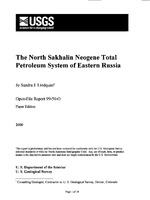The North Sakhalin Basin Province of eastern Russia contains one Total Petroleum System (TPS) ? North Sakhalin Neogene ? with more than 6 BBOE known, ultimately recoverable petroleum (61% gas, 36% oil, 3% condensate). Tertiary rocks in the basin were deposited by the prograding paleo-Amur River system. Marine to continental, Middle to Upper Miocene shale to coaly shale source rocks charged marine to continental Middle Miocene to Pliocene sandstone reservoir rocks in Late Miocene to Pliocene time. Fractured, self-sourced, Upper Oligocene to Lower Miocene siliceous shales also produce hydrocarbons. Geologic history is that of a Mesozoic Asian passive continental margin that was transformed into an active accretionary Tertiary margin and Cenozoic fold belt by the collision of India with Eurasia and by the subduction of Pacific Ocean crustal plates under the Asian continent. The area is characterized by extensional, compressional and wrench structural features that comprise most known traps.


